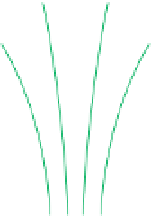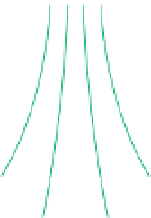Geoscience Reference
In-Depth Information
The same principle applies to subsurface conductors,
where the location, attitude and geometry of a buried
conductor with respect to the primary magnetic
field deter-
mine the coupling between them.
Figure 5.70
illustrates this
with a large transmitter loop on the ground surface and
sheet-like conductors in the subsurface. Depending on its
location and orientation relative to the loop, the conductor
may be well coupled, poorly coupled or null coupled with the
primary
field produced by the loop. At any location, max-
imum coupling (i.e. maximum eddy current
ow) and the
strongest secondary magnetic
field occur when the primary
field is perpendicular to the plane of the conductive body.
Establishing a geometry whereby the target is intersected by
the primary magnetic field at as high an angle as possible is
fundamental to creating a strong eddy current system.
Optimum coupling between transmitter and conductor is
fundamental for the detection of the conductor.
Once detected, poor coupling and null coupling are used
to advantage to provide diagnostic information about the
location and attitude of a conductor with respect to the
primary
Well
coupled
Well
coupled
Null
coupled
Magnetic
field lines
Tx
Null
coupled
Very well
coupled
Very well
coupled
field. This is achieved by relocating the transmitter
loop relative to the conductor and observing changes in its
response. For example, in
Fig. 5.70a
the vertical-dipping
conductor is well coupled to the loop when the loop is
located to the side of the conductor, and null coupled when
the centre of the loop is located directly above it
is very well coupled (
Fig. 5.70c
), and poorly coupled when
the loop is to the side of the conductor (
Fig. 5.70d
)
.
Well
coupled
Poorly
coupled
Null
coupled
Figure 5.69
Variation in coupling between conductors, represented
by small loops, and the magnetic field of a large current-carrying
loop (Tx) at various locations around the Tx. Maximum coupling
occurs where the magnetic field intersects the plane of the conductor
loop perpendicularly.
a)
c)
Eddy current
flow
Target
conductor
b)
d)
Primary magnetic
field lines
Figure 5.70
Variations in coupling to vertical and
flat-lying sheet-like conductors in the subsurface for various locations of a horizontal loop on
the surface. The conductor is (a) well coupled, (b) null coupled, (c) very well coupled, and (d) poorly coupled.


























































































































































































































Search WWH ::

Custom Search